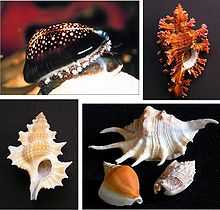Caenogastropoda
| Caenogastropoda Temporal range: Carboniferous – Recent[1]:355 | |
|---|---|
 | |
| Various examples of Caenogastropoda | |
| Scientific classification | |
| Kingdom: | Animalia |
| Phylum: | Mollusca |
| Class: | Gastropoda |
| (unranked): | clade Caenogastropoda Cox, 1960[2] |
Caenogastropoda (from Ancient Greek caeno- meaning "recent") is a taxonomic clade, a large diverse group which are mostly sea snails and other marine gastropod mollusks, but also includes some freshwater snails and some land snails.
Caenogastropoda contains many families of shelled marine molluscs including the periwinkles, cowries, wentletraps, moon snails, murexes, cone snails and turrids.
About 60% of all living gastropods belong to the Caenogastropoda.[3]
The clade Caenogastropoda is, based on optimal phylogenetic analysis, deemed monophyletic.[4]
Biology
The Caenogastropoda exhibit torsion and thus, are included in what was previously been called the Streptoneura (meaning twisted nerves), also known as Prosobranchia (meaning gills forward). Specifically, they are characterized by having only a single auricle in the heart and a single pair a gill leaflets, and are equivalent to the Monotocardia or Pectinobranchia of older authors.
Taxonomy
The taxon Caenogastropoda was first established by Leslie Reginald Cox in 1960 as a superorder[5] but now sometimes it is retained as a clade. This group combines the older taxa Mesogastropoda and Stenoglossa from classification by Johannes Thiele[6] and is equivalent to the Monotocardia as defined by Mörch in 1865, as revised.
Caenogastropoda can be divided into two major groups based on the anatomy of the radula:
- Taenioglossa (from taenio meaning band) which are the older Mesogastropoda in which there are typically seven teeth in each radular row.
- Stenoglossa (from steno meaning narrow), the Neogastropoda, in which there are only 1-3 teeth per row.
1997 taxonomy
Ponder & Lindberg, 1997 and others since (e.g. Vega et al., 2006;[7] Harzhauser, 2004;[8] and Pina, 2002.[9]) show Caenogastropoda as a superorder, following the sense of Cox, 1960. More recently Bouchet & Rocroi, 2005 revised Caenogastropoda as a clade.
2005 taxonomy
The following classification was laid out in the taxonomy of Bouchet & Rocroi (2005):[6]
- Caenogastropoda of uncertain systematic position
- an informal group Architaenioglossa
- clade Sorbeoconcha
- clade Hypsogastropoda
2006 taxonomy
Colgan et al. (2006)[10] provided further insight into the phylogeny of Caenogastropoda.[2]
Latest views by the World Register of Marine Species
Sorbeoconcha should be considered an alternate representation of Caenogastropoda.
Sorbeoconcha should include [Cerithioidea + Campaniloidea + all Hypsogastropoda (i.e. the remaining Caenogastropoda)], see definition in Ponder & Lindberg, 1997: 225, not only [Cerithioidea + Campaniloidea] as suggested by the indent pattern in Bouchet & Rocroi. Neotaenioglossa Haller, 1892 suggested in Ruud Bank’s draft for Fauna Europaea is not retained because it would need severe emendation to remove Pyramidellids, Cerithioids, etc.. included in its original definition, and therefore would be too far from Haller's concept if it were to fit the concept of Sorbeoconcha. Although cladistically sound, the taxon Sorbeoconcha is skipped in the classification scheme because (1) ten years after its publication, the name still sounds unfamiliar to most and (2) it is not very helpful in the classification because it includes the bulk of Caenogastropoda (only keeping out small stem groups Abyssochrysidae, Provannidae, and the architaenioglossate taxa). This is not final, opinions are welcome.[11]
References
- ↑ Ponder, W. F.; Colgan, D. J.; Healy, J.; Nützel, A.; Simone, L. R. L.; Strong, E. E. (2008). "Caenogastropoda". In Ponder, W. F. and Lindberg, D. L. Phylogeny and Evolution of the Mollusca. Berkeley: U. California Press. pp. 331–383. hdl:10088/7547.
- ↑ 2.0 2.1 Cox L. R. (1960). In: Moore R. C. (ed.) Treatise on invertebrate paleontology. Part I., Mollusca 1, Gastropoda. The Geological Society of America, University of Kansas Press, Lawrence. xxiii + 351 pp., page 311.
- ↑ Hayes K. A., Cowie R. H. & Thiengo S. C. (2009). "A global phylogeny of apple snails: Gondwanan origin, generic relationships, and the influence of outgroup choice (Caenogastropoda: Ampullariidae)". Biological Journal of the Linnean Society 98(1): 61-76. doi:10.1111/j.1095-8312.2009.01246.x.
- ↑ Stephanie W. Aktipis, Gonzalo Giribet (2010), A phylogeny of Vetigastropoda and other “archaeogastropods”: re-organizing old gastropod clades, Invertebrate Biology > Vol 129 Issue 3; p. 220-240
- ↑ Caenogastropoda, Paleobiology
- ↑ 6.0 6.1 Bouchet P., Rocroi J.-P., Frýda J., Hausdorf B., Ponder W., Valdés Á. & Warén A. (2005). "Classification and nomenclator of gastropod families". Malacologia: International Journal of Malacology (Hackenheim, Germany: ConchBooks) 47 (1-2): 1–397. ISBN 3925919724. ISSN 0076-2997.
- ↑ F. J. Vega et al. 2006. El Espinal, a new plattenkalk facies locality from the Lower Cretaceous Sierra Madre Formation, Chiapas, southeastern Mexico. Revista Mexicana de Ciencias Geológicas 23(3):323-333
- ↑ Harzhauser M. (2004). "Oligocene gastropod faunas for the Eastern Mediterranean (Mesohellenic Trough/Greece and Esfahan-Sirjan Basin/Central Iran)". Courier Forschungsinstitut Senckenberg 248: 93-181.
- ↑ A.Pina -Caenogastropoda
- ↑ Colgan D. J., Ponder W. F., Beacham E. & Macaranas J. (2006). "Molecular phylogenetics of Caenogastropoda (Gastropoda: Mollusca)". Molecular Phylogenetics and Evolution 42(3): 717-737. doi:10.1016/j.ympev.2006.10.009 PDF
- ↑ Gofas, S. (2013). Sorbeoconcha. Accessed through: World Register of Marine Species at http://www.marinespecies.org/aphia.php?p=taxdetails&id=382203 on 2013-06-28
External links
| Wikimedia Commons has media related to Caenogastropoda. |
| Wikispecies has information related to: Caenogastropoda |